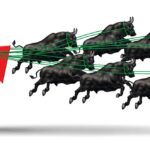

We know that collaborating with generative AI (GenAI) can boost workers’ performance on tasks that they already have the skills to complete. But what if GenAI can also help workers perform tasks that they had no chance of completing on their own? That is, not only enhance performance but also expand workers’ capabilities outside their area of expertise?
Our research shows that GenAI can do just that for a company’s workforce—a shift that could not only transform talent strategies but also redefine the competitive landscape for many companies with limited access to expertise.
This new insight into how workers and technology interact comes from BCG Henderson Institute’s recent scientific field experiment, conducted with scholars from Boston University and OpenAI’s Economic Impacts Research Team. While there are many caveats and complexities, the results showing evidence of expanded worker capability have enormous implications for businesses—particularly small- and medium-sized enterprises (SMEs) that are often constrained by a scarcity of specialists.
Many have postulated that GenAI has the potential to democratize access to expertise for both individuals and businesses. MIT economist David Autor has gone even further, arguing that AI can “help rebuild the middle class” by enabling “a larger set of workers equipped with necessary foundational training to perform higher-stakes decision-making tasks currently reserved for elite experts.” Whether Autor’s theory of middle-class revival plays out or not, the empirical findings from our recent experiment strongly suggest that he’s onto something when it comes to workers and expertise. While by no means substituting for genuine experts, workers using GenAI can sufficiently approximate expert performance to carry out tasks previously beyond their skillset to accomplish.
For businesses, this expansion challenges deep-seated assumptions about talent acquisition strategies that are based on the belief that skills and knowledge rest solely with the individual worker, rather than being a combination of the worker and technology. In the domain of knowledge work, especially as GenAI models continue to develop, we argue that businesses should increasingly use the human-GenAI coupling—the “augmented” worker—as the relevant unit of analysis. Just as an exoskeleton enhances human movement beyond natural limits, GenAI empowers workers to tackle tasks that would otherwise be out of their reach.
Such a shift would not only transform companies’ talent strategies, particularly for hiring and development but also redefine the labor marketplace for companies more generally. SMEs, for example, would be able to punch above their weight by augmenting their workforce with AI capabilities, empowering them to compete with larger companies that have ascended based on superior access to specialized human capital. Levelling the playing field of expertise would enable SMEs to innovate, scale, and deliver high-quality outcomes that were previously out of reach.
An expansion of capabilities—for everyone
Our experiment on GenAI collaboration focused on worker capabilities related to data science, yet we can extrapolate more broadly to other areas of expertise. In marketing, product development, graphic design, or legal services, workers “augmented” by GenAI are likely capable of performing tasks close to the level of specialists, even when those tasks are outside their current field of expertise.
In the experiment, participants using ChatGPT were able to complete data science tasks, such as coding, predictive analytics, or statistical understanding, at 75%-90% of the performance of specialized data scientists working without GenAI. While the augmented workers may not match the precision of true specialists, they nevertheless represent a significant opportunity for companies previously lacking adequate access to expertise.
Regardless of their backgrounds, all the consultants with access to ChatGPT outperformed their peers completing the experiment’s tasks without it. Even when someone had no prior experience in coding or statistics whatsoever, but had access to ChatGPT, that individual was still able to come close to the performance of unassisted data specialists. This suggests that companies can rapidly improve their performance without overhauling their workforce or organizational structure.
While we saw ChatGPT expand the capabilities of everyone in our experiment, performance gains were even greater for workers with a certain background. Across all data-related tasks, even those unrelated to coding, participants with coding experience performed on par with unassisted data scientists. This finding hints at the possibility that certain skills impact a worker’s ability to derive the most value from being augmented by GenAI, such as the ability to break a problem down into subcomponents. In other areas of expertise, be it marketing or legal services, other backgrounds besides coding might be more helpful. Moreover, as GenAI models continue to evolve, the specific skills associated with higher performance for augmented workers may themselves shift over time.
When workers can perform higher-stakes, decision-making tasks—those currently reserved for elite experts—their professional identity thrives. According to our study, 70% of participants said using GenAI gave them greater confidence in their professional abilities, helping them feel more competent and increasing their sense of autonomy. This shift in attitude suggests that augmented workers, in all types of organizations, could see their professional identity strengthened—rather than undermined—by the appropriate use of GenAI.
The enduring need for experts
The expansion of capabilities enabled by GenAI is not without complexities, and there are limitations that business leaders should be mindful of that point to the continued need for deep expertise and some form of supervision, even as access to expert capabilities is democratized.
For starters, the experiment revealed that participants who were successfully “augmented” by GenAI for the completion of basic data science tasks are not genuinely “reskilled.” A knowledge test given to all participants showed that those who had used GenAI subsequently performed no better than their peers after the technology was no longer available. Put another way: They had not gained knowledge that would enable them to become proper data scientists without GenAI’s help. This is why we refer to GenAI as an exoskeleton—a tool that enhanced their ability to perform tasks that would have been otherwise out of their reach, without teaching them how to do these tasks on their own.
A key question, then, is to what extent augmented workers should engage in high-risk or complex tasks beyond their expertise. In the data science experiment, participants successfully completed basic tasks, but this does not imply they can handle more complex or technical assignments like experienced data scientists. Augmented workers must still validate the technology’s output, which requires some expertise and possibly specialist oversight. If identifying or recruiting even a few specialists proves difficult, companies must weigh the benefits and risks of augmentation and possibly focus on lower-risk or less complex tasks within the “frontier” of GenAI’s capabilities. The question, then, is: When and how should companies harness the GenAI-fueled expansion of workers’ capabilities?
How leaders can seize untapped opportunities from GenAI
There isn’t a blueprint for change management, and in many cases, the range of possibilities depends on a company’s organizational set-up and resources. Nevertheless, there are five overarching steps that business leaders can take immediately to take advantage of what GenAI has to offer their workforce.
Identify: The first and most urgent step is for a company to determine what expertise and specialist capabilities it’s lacking. Some questions that can help define those deficits: What expertise are our competitors capitalizing on that we currently lack? Are there critical functions where we rely heavily on third-party vendors or consultants due to an internal lack of expertise?
Start: The second step is to run pilot projects to see whether GenAI can expand the workforce’s capabilities in the areas where it lacks expertise. Early results from these pilots should be closely monitored to make sure that a company’s augmented workforce can perform comparably to specialists.
Boost: The third step is to establish if any particular background training provides skills that further enhance performance, similar to coders in our experiment having a background skillset to squeeze out additional performance on data science tasks. Business leaders should consider targeting workers with those backgrounds to adopt “GenAI as an exoskeleton” in order to complete tasks outside of their field of expertise.
Reorganize: The fourth step is to explore how best to involve specialists to conduct reviews of augmented workers’ output. This may require redistributing responsibilities, redesigning processes, and strategically reassessing workforce composition. That could mean creating new, smaller roles for specialists and embedding GenAI checkpoints into workflows.
Train: The fifth step is to ramp up worker training on GenAI’s capabilities and limitations, including educating workers on when specialist involvement is essential.
***
If business leaders take these steps, they are positioning their organization not only to get more out of workers in their existing roles, but to expand their capabilities. The ability to expand who can do close-to-expert-level work on specific tasks creates unprecedented opportunity, particularly for companies with limited access to specialized talent. What are currently scarce resources that are competitive and costly to access, like digital marketers or data scientists, may soon become more widely available to more companies in the marketplace, potentially levelling the competitive playing field. Individual workers benefit too, as they can collaborate with GenAI to enhance their professional identity and remain competitive as automation transforms tasks.
Read other Fortune columns by François Candelon.
François Candelon is a partner at the private equity firm Seven2 and the former global director of the BCG Henderson Institute (BHI).
Lisa Krayer is a principal in BCG’s Washington, D.C. office and a former ambassador at BHI.
Daniel Sack is a managing director and partner at BCG’s Stockholm office.
Emma Wiles is an assistant professor of information systems at Boston University’s Questrom School of Business.
Riccarda Joas is a consultant at BCG’s Munich office and an ambassador at the BHI















